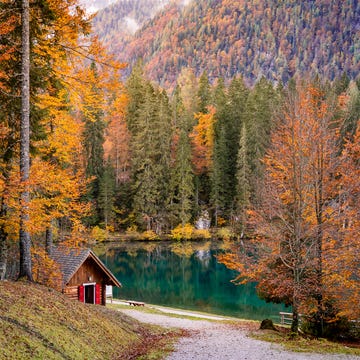1Japanese Maple
 Jacky Parker Photography//Getty Images
Jacky Parker Photography//Getty ImagesWith their finely lobed leaves and colorful hues, Japanese Maple trees are well-loved as a source of fall color! The Japanese Maple typically ranges from 10 to 15 feet tall, and as temperatures begin to drop, the leaves of these elegant trees transform into a breathtaking palette of vibrant reds, oranges, and yellows. This species is often planted in Japanese-style gardens but will add lots of texture and visual interest to any outdoor space!
USDA Growing Zones: 5 to 8
Sun Exposure: Full sun to part shade
2Ginkgo Biloba
 Twenty47studio//Getty Images
Twenty47studio//Getty ImagesIn the fall, it's easy to point out a ginkgo tree due to its unique, honey-colored, fan-shaped leaves that stand out in a variety of landscapes. Plus, ginkgo leaves tend to retain their color for an extended period, making them a reliable option for autumn displays.
USDA Growing Zones: 4 to 9
Sun Exposure: Full to partial sun
Advertisement - Continue Reading Below
3Black Gum
 gardendata//Getty Images
gardendata//Getty ImagesBlack gum trees are known and loved for their star-shaped leaves that shift to shades of scarlet, bright red, and even purple in the fall. They yield small, bluish-black fruit in the fall that provides nutrients to many mammals and birds and can grow up to 100 feet tall, although they're usually in the 20 to 30-foot range.
USDA Growing Zones: 3 to 9
Sun Exposure: Full sun to part shade
4Sugar Maple
 Malorny//Getty Images
Malorny//Getty ImagesAnother maple tree that's sure to bring fall color into your life is the sugar maple! With their magnificent height range of 40 to 120 feet and vibrant displays of fall foliage in the Northeastern United States, these trees are an attraction within themselves. To guarantee lots of fall color, opt for 'Fall Fiesta,' a variety known for its vibrant red, orange, and yellow leaves.
USDA Growing Zones: 3 to 8
Sun Exposure: Full sun to part shade
Advertisement - Continue Reading Below
5Sumac
 Pito Fotos//Getty Images
Pito Fotos//Getty ImagesThe sumac tree's stunning, fern-like compound leaves are a surefire way to add interest and texture to any landscape. In the fall, sumac's green and yellow foliage turns red, orange, or purple. The most popular varieties to grow are the smooth sumac and staghorn sumac, which grow to be around 10 to 15 feet tall.
USDA Growing Zones: 3 to 9
Sun Exposure: Full sun to part shade
6American Sweetgum
 Olga Kaya//Getty Images
Olga Kaya//Getty ImagesWhile dazzling fall foliage isn't always promised, when the leaves of American sweetgum do change, it's an absolute feast for the eyes! In the fall, they transform into a dazzling mix of red, orange, yellow, and even purple, which last for weeks. Plus, sweetgums are pretty adaptable, thriving in various soil types, making them a great choice for different landscapes.
USDA Growing Zones: 4 to 9
Sun Exposure: Full sun
Advertisement - Continue Reading Below
7Beech
 James Warwick//Getty Images
James Warwick//Getty ImagesIf you're looking for a way to prolong those fleeting bursts of fall color, consider planting a beech tree! These tall trees (ranging from 20 to 80 feet) change from green to golden-bronze later in the season and retain their leaves for longer, making them the perfect addition to any garden.
USDA Growing Zones: 3 to 9
Sun Exposure: Full sun to part shade
8Dogwood
 NoDerog//Getty Images
NoDerog//Getty ImagesDogwood trees might get all the credit for the delicate flowers that bloom on their branches in the spring, but they're also a great source of autumn color! This underrated gem boasts leaves in shades ranging from orange to reddish-purple in the fall and grows around 25 feet tall.
USDA Growing Zones: 5 to 9
Sun Exposure: Full sun to part shade
Advertisement - Continue Reading Below
9Purple-Leaf Sand Cherry
 Cynthia Shirk//Getty Images
Cynthia Shirk//Getty ImagesAlthough this one is technically a large shrub, it's still a worthy option if you're looking for a way to infuse fall color into your yard. As the seasons shift from summer to fall, the purple-leaf sand cherry's reddish-purple foliage turns to a pleasant greenish-bronze.
USDA Growing Zones: 2 to 8
Sun Exposure: Full sun
10White Oak
 Douglas Sacha//Getty Images
Douglas Sacha//Getty ImagesThis grand, deciduous tree makes the marvelous transition from dark green to reddish-brown, which contrasts beautifully with its ash-gray bark, in the fall. White oak trees are usually among the first oaks to have their lobed, oblong leaves change color during the season.
USDA Growing Zones: 3 to 9
Sun Exposure: Full sun

Nitya Rao is the editorial assistant at The Pioneer Woman, covering stories ranging from food, fashion, beauty, lifestyle, news, and more.
Advertisement - Continue Reading Below
Advertisement - Continue Reading Below
Advertisement - Continue Reading Below























